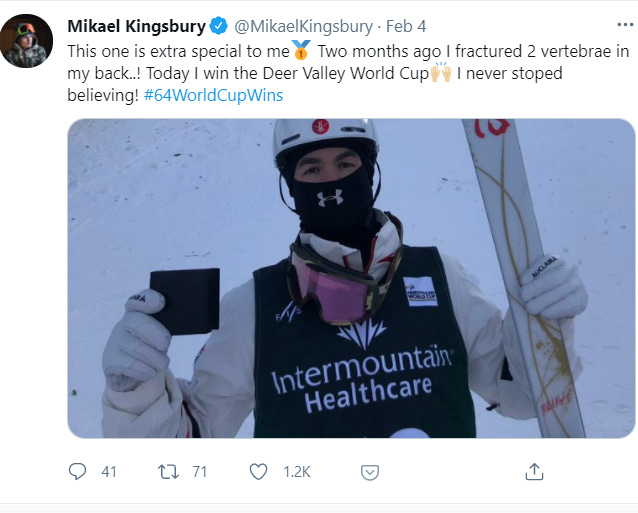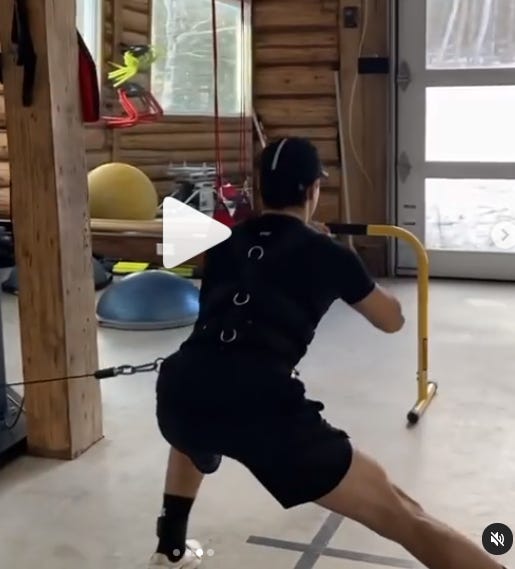Olympic Gold Medalist Freestyle Skier Mikael Kingsbury’s Recent Injury Rehab & Return To Competition Highlights All That It Takes To Be A Champion.
The commitment required. Part 1 of series examining what is required in 2021 for young athletes to compete at the highest levels of sport.
While teenagers all go through a roller coaster ride in trying to find their way in life, many young athletes are eyeing competing at the next level in their chosen sport as their main objective.
The athletes’ focus, their families’ focus and all available resources are often directed towards that goal of competing at the next level. That next level can look different based on the timelines standardized within that sport for optimum development. Gymnastics and figure skating for example have different timelines than some team sports in terms of where young athletes need to be at certain ages to have a chance to compete at the highest levels.
This is the first part in a series examining the commitment required for an adolescent athlete to develop and move on to the next level. That next level could be elite competition outside of school (like the Canadian Hockey League), college athletics (as in scholarships and university sports), professional and/or international and Olympic competition.
Scott Livingston has worked with elite athletes for most of his professional career spanning almost 30 years. As a strength & conditioning and performance coach at the university, Olympic and professional level, he has supported many (Scotty’s Leave Your Mark podcast provides some great insight into performance coach as well as strategies and experiences supporting the journey to living our best life. Details below).
Scotty knew something was different up in November 2020 when he received a text from a fellow coach that one of his pupils and mentees Mikael Kingsbury, an elite freestyle skier competing on the international circuit had suffered an spine fracture during a practice run in Finland. Mik is an Olympic gold (2018) and silver (2014) medalist and the world record holder for most world cup wins and a 4x world champion. This was not just an injury, it was Mik’s first and involved his vertebrae.
What makes this story significant is that by early February 2021 Mik was not only back competing on the circuit but won in consecutive events. The following goes through what was required to turn this injury around and get back to an elite championship level during a pandemic in record time.
“It takes a village to raise a child”- African proverb
Developing athletes from competitive to elite level requires a huge commitment. Contrary to popular mantra, it is not just about athlete desire. It is also about having a support team, funding, a massive amount of focus, talent, unreal work ethic as well as some good fortune and additional help along the way.
Mikael Kingsbury benefitted, as did many other athletes of the support of B2ten, a Canadian initiative of funding by philanthropists to support the financial demands of pursuing athletic excellence. Initially conceived in 2008 with a push to 2010 Vancouver Olympic performance by Canadian athletes, it continues to operate today and evolved funding to also include contributions to Active for Life, a resource designed for parents to support children in their development of physical literacy. Having a support team of high-performance sports scientists, doctors, psychologists, physios, strength and conditioning trainers is essential in the development of athletes does not come without a cost.
This cost and investment paid off, not only over time in supporting Mik Kingsbury on the slopes and in the gym, but when he needed it the most during rehabilitation from a serious injury.
As Scott Livingston describes it, the communication post injury was swift and inclusive of coaches, doctors, physiotherapist, psychologist and parents. (Imagine hearing your son/daughter has been injured on the other side of the world and has a spine fracture. The family life supporting an athlete has its pitfalls like any other.)
Even though Kingsbury had not had an injury in his 12 year career (a topic for another day), the team around him had experience in active rehab and quickly charted a course towards recovery and resuming competition.
As a side note, as parents and coaches we can all relate to this long period of time without competition due to COVID. Resumed competition often results in a shortened season, and to incur an injury in training camp, can be devastating on many levels.
Mik returned to Canada, started rehab in a setting that was led by professionals who used advanced practices around as their guide in prescribing activities that were accommodating in nature.
Active rehabilitation has become the norm in the 2021 high performance world. This was not always the case. 10, 15 or 20 years ago immobilization for an extended period of time would have been the first prescribed course of action.
Scotty uses the ACL reconstruction evolution over the last 30 years as a way to explain. Up to the last 10 years, immobilization and bracing would have been the course of action for weeks and months in rehabbing the knee procedure. Today, limited weightbearing and supported movement are implemented quickly. The science and track record around this type of rehab is very strong in getting injuries dealt with and athletes back competing in record time.
The rehab process was going well all things considered back here in Canada, until our athlete caught COVID. That was another hurdle around recovery that was fortunately not a major obstacle, but one added wrinkle that continued to require lots of support to help navigate to get back on course.
Rehabilitation from chipped vertebrae and then from COVID, long distance travel and quarantines, distancing requirements and some limited access to facilities all provided obstacles that were overcome with a team effort of communication, collaboration and of course athlete focus and work ethic.
We must not forget that unless the athlete is focused and committed to making the sacrifices to being the best they can, even the most comprehensive support will not be enough to compete at the highest levels.
The Mik Kingsbury story of coming back from this injury is a great example of doing what was required to come back and come back strong and all the support he required to get there. Without that infrastructure, he may have lost a season and performance capacity in the rest of his career.
The implications for all athletes and athletic minded of having a strong support network run deep. The power of being strong and fit has a significant impact on recovery time. Scotty shared that going into fall training camp in Finland, Mik was in tremendous shape. A proactive approach always trumps a reactive one. This carries meaning for all of us coaches, parents, officials as well as athletes.
Special thanks to Scotty Livingston, a true professional, in providing the insight and details in supporting this story.
PLAY. LEAD. BE STRONG.
Additional resources in support of this article:
Mikael Kingsbury Website : http://kingsbury.mli.st/
Scott Livingston Leave Your Mark Podcast: https://podcasts.apple.com/ca/podcast/leave-your-mark/id1367473181
B2Ten: https://b2ten.com/
Active For Life: https://activeforlife.com/about/







